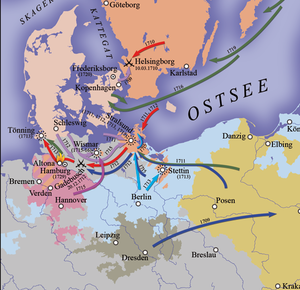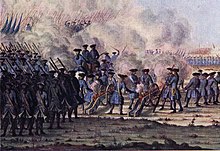Stenbock campaign
| date | September 3, 1712 to May 16, 1713 |
|---|---|
| place | Swedish-Pomerania , Holstein-Gottorp and Mecklenburg |
| output | Allied victory (Denmark, Saxons and Russians) |
| Parties to the conflict | |
|---|---|
| Commander | |
|
Field Marshal Magnus Stenbock |
Denmark: |
| Troop strength | |
| 15,600 men | 36,000 men |
The Stenbock campaign from September 1712 to May 1713 was a failed Swedish operation under the command of Magnus Stenbock on the North German theater of war in the Great Northern War .
prehistory
In August 1711, Russian , Danish and Saxon soldiers marched into Swedish Pomerania , occupied the country and blocked a large area of the Stralsund fortress .
Charles XII. planned the Swedish operations in Bender while in Ottoman exile . His intention was to significantly strengthen the associations in Swedish Pomerania. Then the Saxon and Russian troops were to be driven out of Swedish Pomerania again and a northern pincer arm should be formed against the Russian troops standing near Stettin . Field Marshal Magnus Stenbock was entrusted with carrying out the operation. Stenbock played a key role in the Swedish successes in Poland-Lithuania from 1700 to 1706 .
Course of the campaign
Transfer of the army to Rügen
First of all, the sea route to Rügen had to be secured. The balance of power in the Baltic Sea favored the Swedes. Denmark was able to muster significantly fewer warships at the given time . The Danish preparations for the landing of larger formations on Rügen were known to the Danes, but the Danish formations did not set sail until mid-August.
Admiral Wachtmeister left Karlskrona on September 3, 1712 with 24 warships and three frigates with a total of 1746 cannons and 11,130 men. On board the ships were 2711 infantrymen from the regiments Uppland and Calmar. There were also a number of infantrymen and cavalrymen from various units. On September 4, there was a brief gun battle between four Swedish and several Danish ships. The Swedes won another small sea battle the next day, so the Danes avoided the Køgebucht . Now the transport ships from Karlshamn went to sea to transfer provisions and weapons to Rügen. Stenbock planned the further conduct of operations from Putbus and for this purpose met with the commander-in-chief of the Swedish troops in Western Pomerania, Lieutenant General Karl Gustav Düker , and his staff .
On September 18, 1712, allies under Russian command carried out a landing attempt on the south coast of Rügen, which the Swedes fought off. Stenbock went back to Sweden a short time later to inspect the further transports. The failed landing of the Russians in the south of the island made him fear that Rügen might get into enemy hands before the transport arrived. In addition, there were difficult weather conditions, which also made a descent difficult.
On September 19, 1712, the expeditionary force set sail from Karlshamn. Almost 100 transport ships were accompanied by the Swedish fleet. Admiral Ulrik Christian Gyldenløve's fleet now had 22 warships and thus achieved parity with the Swedes.
Loss of the Swedish transport fleet
Stenbock reached Rügen on September 25th. The transport ships were unloaded within the next two days and remained in the bay at the Wittower post office. On September 26th the Danish fleet was already approaching. The 9,423 men landed began to march. The campaign depended on the fate of the transport fleet, as large parts of the supplies and equipment were still in Sweden. In a maneuver on September 29, Gyldenlöwe managed to push his units between the transport fleet and the main forces of the Swedish Navy . The Swedish transport fleet suffered massive losses in the sea battle off Rügen . About 15 ships sank and 42 transporters burned out. Stenbock, who was on Rügen at the time of this military catastrophe, had already failed with the loss of the transport fleet at the beginning of his campaign.
Breakout of the Swedish associations from Stralsund
Stenbock's associations marched to Stralsund , united there with the troops standing in the fortress and broke through the blockade in the Saxon section on November 1, 1712. At that time the Swedish army was 14,000 strong. 2000 soldiers remained to secure Stralsund. Stenbock's destination at that time was Wismar in Sweden . Here he wanted to wait for further transports and reinforcements from Sweden.
On November 3rd, Stenbock's army crossed the Mecklenburg border. At Ribnitz the Swedish troops encountered Saxons again and drove them back in a battle that was costly for the Saxons. When the Swedes invaded Mecklenburg there were 14,000 Russian infantrymen and 8,000 Russian and Saxon cavalrymen near Tribsees ( Western Pomerania ) under the command of August II. Stenbock's army initially did not attack. Without food and ammunition, the Swedish army was too weak for military action. In order to be able to quickly pick up supplies arriving from the sea, the army basically stayed on the coast and crossed the Warnow near Rostock . Stenbock set up his headquarters in Schwaan and placed his troops in the surrounding areas, while the Saxons and Russians were at Güstrow at that time .
Stenbock coordinated diplomacy with military force. He knew of the tense relationship between the Nordic Allies and hoped to negotiate a separate peace with August the Strong. On December 1, he concluded a two-week armistice . A few days later , Danish troops, coming from Hamburg , marched into Mecklenburg under the command of Jobst von Scholten . On December 15, 1712, these troops stopped in the Gadebusch area. On the same day, Stenbock set out for Gadebusch. Stenbock had to operate against the Danes. These specifically prevented the Swedes from getting supplies from the country. With forays they harassed the civilian population and destroyed or confiscated food.
Battle of Gadebusch
On December 14, 1712, the Swedes resumed their advance near the Warnow . Jobst von Scholten's troops stood still further west at Gadebusch . Stenbock's army approached the Danes within ten to twelve kilometers on the evening of December 18. The Danish troops failed to get in touch with the Russian allies south of Lake Schwerin in good time .
In the early morning of December 19, Stenbock attacked the Danes south of Gadebusch near Wakenstedt. At around 1 p.m., the Swedish artillery opened fire, which immediately proved very effective. At nightfall, the fighting ended in a Swedish victory. Despite the tactical and operational success, Stenbocks Korps remained hopelessly inferior.
Fight in Schleswig-Holstein
After the battle was won, the way was free to pursue the actual goals of Charles XII. put into action. The Swedes took the initiative. In December 1712, Stenbock's associations crossed the frozen Trave and temporarily took quarters near Bad Segeberg . On December 27, the Danes left their winter quarters in Lauenburg to attack the Stenbock Corps again. She was surprised by the news that the Swedes ignored the Danish fortresses of Rendsburg and Glückstadt and instead swung south to Altona.
Parts of the Danes marched again to Mecklenburg, where they united with Saxon and Russian troops at Crivitz , while a second army detachment dodged north to unite with fresh troops. In the meantime, Stenbock had the city of Altona set on fire.
The stenbock associations also plundered the Holstein marshland . Stenbock's army marched to Friedrichstadt at the end of January 1713 . On January 24, strong Allied forces under the Russian general Christian Felix Bauer attacked Swedish outposts on the Treene .
Surrender of the Swedes
In negotiations with Holstein-Gottorf , the marshal succeeded in winning the Tönning fortress as a station for his corps. While strong Allied forces attacked Stenbock's troops near Friedrichstadt on February 12th, others relocated to Tönning by occupying Koldenbüttel .
The Swedes successfully attacked these opponents with cavalry regiments and marched on to Tönning. Several regiments were quartered in this fortress, and others in the west of Eiderstedt . In Tönning, Stenbock was confronted with an unbearably poor supply situation. Persevering in the fortress was hopeless. The army command wanted to return the units to Mecklenburg. The attempt to cross the river again was discovered by the Nordic allies. The allies reacted immediately by drawing together all available forces, three times superior to those of the Swedes. Thus, on the Swedish side, all hope of a happy outcome of the campaign vanished. In mid-April, Stenbock's army made one last attempt to break through enemy lines in the direction of Friedrichstadt. It failed due to opposing resistance. Instead, on April 26, 1713, the Allies forced the Swedes to retreat to Tönning fortress. The formal siege began on May 4, 1713. It ended with the surrender of Stenbock on May 16. Stenbock was taken to Copenhagen as a prisoner .
Effects of the campaign
The Stenbock campaign was closely watched internationally. It brought severe suffering to the population directly affected by drafts. When Tsar Peter found out about the burning of Altona, he ordered four Western Pomerania cities to be set on fire in retaliation as well: Gartz on the Oder , Wolgast , Anklam and Demmin . Gartz went up in flames on March 16, 1713, and Wolgast burned eleven days later. When Russian troops tried to set fire to Anklam, the Danish admiral Christian Thomsen Carl asked the Russian General Staff for a delay. Staff rejected his ally's request. Carlson then referred to Staff as a murder burner. Both then led a duel. It was held on the Greifswald market square and ended with Carl's death. Staff was then imprisoned, so the city of Anklam gained time. Shortly after the incident, a messenger from Alexander Danilowitsch Menshikov arrived in Greifswald, who brought Peter's order to be lifted.
Sweden's last major offensive in northern Germany turned out to be a futile attempt by Charles XII to take the initiative again. The main reason for this was the destruction of the transport fleet in September 1712.
literature
- Martin Meier: The Stenbock Campaign 1712/1713 - A contribution to the history of operations, Universitätsverlag Potsdam, Potsdam 2012 in: Military and Society in the Early Modern Age 16 (2012) 2, pp. 197-217
- 300 years of the battle of Gadebusch. International conference from October 12 to 14, 2012 in Gadebusch (= publications by the Chair of Nordic History. Vol. 18). Ernst Moritz Arndt University, Greifswald 2014, ISBN 978-3-86006-419-1 .
- News about the fire in Altona in 1713, (Ed.) Heinrich Christian Mantel, Altona 1714
- The burned down of Altona in 1711 and 1713
- Knut Lundblad: History of Charles the Twelfth, King of Sweden, Volume 2. Hamburg 1840




